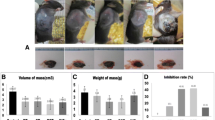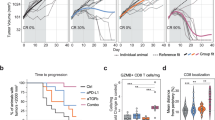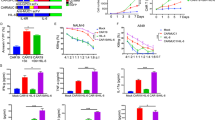Abstract
The contribution of immune cells in soft tissue sarcomas (STS) is not completely known and understanding their role is very essential for employing immunotherapy strategies. Here, we show that murine fibrosarcoma-conditioned medium promoted total spleen cell proliferation but inhibited T cell responses to mitogenic and allo-antigen-mediated stimulation. This increased proliferation was found to be in B cells resulting in generation of Breg further leading to Treg population. This was found to be the same in vitro and in vivo. The phenotype of these B cells was CD19+CD81+CD27+CD25+PD-L1hi and they secreted both IL-10 and TGF-β. These tumor evoked Bregs (tBreg), when co-cultured with B depleted T cells, suppressed their proliferation in response to anti-CD3/CD28 stimulation. tBreg-induced suppression of T cell responses was not abrogated by the inhibition or neutralization of IL-10 but by the small molecule inhibitor of TGFβ Receptor type I, SB431542. While SB531542 per se was not cytotoxic to tumor cells, administration of SB431542 in tumor-bearing mice (TBM) significantly reduced the tumor burden. In addition, the treatment significantly reduced Treg cells and rescued proliferation of T cells in response to mitogen and allo-antigen. Collectively, our results identify that tumor evoked Breg cells mediate T cell immune suppression through TGFβ-mediated pathway and that targeting the Breg–Treg axis can be potentially used as an immunotherapy agent.






Similar content being viewed by others
Abbreviations
- FASL:
-
Fas ligand
- GATA3:
-
GATA-binding protein 3
- NT:
-
Non-tumor
- RORγ:
-
RAR-related orphan receptor gamma
- STS:
-
Soft tissue sarcoma
- Tbet:
-
T-box transcription factor
- TBM:
-
Tumor-bearing mouse
- TCM:
-
Tumor-conditioned medium
- TDLN:
-
Tumor draining lymph node
- UT:
-
Untreated
References
Fletcher CD (2014) The evolving classification of soft tissue tumours—an update based on the new 2013 WHO classification. Histopathology 64:2–11
Lawrence W, Donegan WL, Natarajan N, Mettlin C, Beart R, Winchester D (1987) Adult soft tissue sarcomas. A pattern of care survey of the American College of Surgeons. Ann Surg 205:349–359
Christie-Large M, James SL, Tiessen L, Davies AM, Grimer RJ (2008) Imaging strategy for detecting lung metastases at presentation in patients with soft tissue sarcomas. Eur J Cancer 44:1841–1845
Lindberg RD, Martin RG, Romsdahl MM, Barkley HT (1981) Conservative surgery and postoperative radiotherapy in 300 adults with soft-tissue sarcomas. Cancer 47:2391–2397
Jacobs AJ, Michels R, Stein J, Levin AS (2015) Improvement in Overall Survival from Extremity Soft Tissue Sarcoma over Twenty Years. Sarcoma 2015:279601
Tanaka A, Sakaguchi S (2017) Regulatory T cells in cancer immunotherapy. Cell Res 27:109–118
Crunkhorn S (2017) Cancer immunotherapy: targeting regulatory T cells. Nat Rev Drug Discov 16:754
Pahl J, Cerwenka A (2017) Tricking the balance: NK cells in anti-cancer immunity. Immunobiology 222:11–20
Noy R, Pollard JW (2014) Tumor-associated macrophages: from mechanisms to therapy. Immunity 41:49–61
Brodt P, Gordon J (1978) Anti-tumor immunity in B lymphocyte-deprived mice. I. Immunity to a chemically induced tumor. J Immunol 121:359–362
Nelson BH (2010) CD20 + B cells: the other tumor-infiltrating lymphocytes. J Immunol 185:4977–4982
Gass JD (1985) Comparison of uveal melanoma growth rates with mitotic index and mortality. Arch Ophthalmol 103:924–931
Zhou X, Su YX, Lao XM, Liang YJ, Liao GQ (2016) CD19(+)IL-10(+) regulatory B cells affect survival of tongue squamous cell carcinoma patients and induce resting CD4(+) T cells to CD4(+)Foxp3(+) regulatory T cells. Oral Oncol 53:27–35
Zhou M, Wen Z, Cheng F, Ma J, Li W, Ren H et al (2016) Tumor-released autophagosomes induce IL-10-producing B cells with suppressive activity on T lymphocytes via TLR2-MyD88-NF-κB signal pathway. Oncoimmunology 5:e1180485
Kessel A, Haj T, Peri R, Snir A, Melamed D, Sabo E et al (2012) Human CD19(+)CD25(high) B regulatory cells suppress proliferation of CD4(+) T cells and enhance Foxp3 and CTLA-4 expression in T-regulatory cells. Autoimmun Rev 11:670–677
Olkhanud PB, Damdinsuren B, Bodogai M, Gress RE, Sen R, Wejksza K et al (2011) Tumor-evoked regulatory B cells promote breast cancer metastasis by converting resting CD4+ T cells to T-regulatory cells. Cancer Res 71:3505–3515
Gray D, Gray M (2010) What are regulatory B cells? Eur J Immunol 40:2677–2679
DiLillo DJ, Matsushita T, Tedder TF (2010) B10 cells and regulatory B cells balance immune responses during inflammation, autoimmunity, and cancer. Ann N Y Acad Sci 1183:38–57
Jung J, Choe J, Li L, Choi YS (2000) Regulation of CD27 expression in the course of germinal center B cell differentiation: the pivotal role of IL-10. Eur J Immunol 30:2437–2443
Murray PJ (2007) The JAK-STAT signaling pathway: input and output integration. J Immunol 178:2623–2629
Matsushita T, Horikawa M, Iwata Y, Tedder TF (2010) Regulatory B cells (B10 cells) and regulatory T cells have independent roles in controlling experimental autoimmune encephalomyelitis initiation and late-phase immunopathogenesis. J Immunol 185:2240–2252
Wong SC, Puaux AL, Chittezhath M, Shalova I, Kajiji TS, Wang X et al (2010) Macrophage polarization to a unique phenotype driven by B cells. Eur J Immunol 40:2296–2307
Yanaba K, Bouaziz JD, Matsushita T, Tsubata T, Tedder TF (2009) The development and function of regulatory B cells expressing IL-10 (B10 cells) requires antigen receptor diversity and TLR signals. J Immunol 182:7459–7472
van der Vlugt LE, Zinsou JF, Ozir-Fazalalikhan A, Kremsner PG, Yazdanbakhsh M, Adegnika AA et al (2014) Interleukin 10 (IL-10)-producing CD1dhi regulatory B cells from Schistosoma haematobium-infected individuals induce IL-10-positive T cells and suppress effector T-cell cytokines. J Infect Dis 210:1207–1216
Mizoguchi A, Mizoguchi E, Takedatsu H, Blumberg RS, Bhan AK (2002) Chronic intestinal inflammatory condition generates IL-10-producing regulatory B cell subset characterized by CD1d upregulation. Immunity 16:219–230
Mauri C, Bosma A (2012) Immune regulatory function of B cells. Annu Rev Immunol 30:221–241
Biragyn A, Lee-Chang C, Bodogai M (2014) Generation and identification of tumor-evoked regulatory B cells. Methods Mol Biol 1190:271–289
Bodogai M, Lee Chang C, Wejksza K, Lai J, Merino M, Wersto RP et al (2013) Anti-CD20 antibody promotes cancer escape via enrichment of tumor-evoked regulatory B cells expressing low levels of CD20 and CD137L. Cancer Res 73:2127–2138
Wejksza K, Lee-Chang C, Bodogai M, Bonzo J, Gonzalez FJ, Lehrmann E et al (2013) Cancer-produced metabolites of 5-lipoxygenase induce tumor-evoked regulatory B cells via peroxisome proliferator-activated receptor α. J Immunol 190:2575–2584
Bailey SR, Nelson MH, Himes RA, Li Z, Mehrotra S, Paulos CM (2014) Th17 cells in cancer: the ultimate identity crisis. Front Immunol 5:276
Zhu X, Mulcahy LA, Mohammed RA, Lee AH, Franks HA, Kilpatrick L et al (2008) IL-17 expression by breast-cancer-associated macrophages: IL-17 promotes invasiveness of breast cancer cell lines. Breast Cancer Res 10:R95
Guo B, Li L, Guo J, Liu A, Wu J, Wang H et al (2017) M2 tumor-associated macrophages produce interleukin-17 to suppress oxaliplatin-induced apoptosis in hepatocellular carcinoma. Oncotarget 8:44465–44476
Vykhovanets EV, Maclennan GT, Vykhovanets OV, Gupta S (2011) IL-17 Expression by macrophages is associated with proliferative inflammatory atrophy lesions in prostate cancer patients. Int J Clin Exp Pathol 4:552–565
Schlegel PM, Steiert I, Kötter I, Müller CA (2013) B cells contribute to heterogeneity of IL-17 producing cells in rheumatoid arthritis and healthy controls. PLoS ONE 8:e82580
Ma S, Cheng Q, Cai Y, Gong H, Wu Y, Yu X et al (2014) IL-17A produced by γδ T cells promotes tumor growth in hepatocellular carcinoma. Cancer Res 74:1969–1982
Jung MK, Kwak JE, Shin EC (2017) IL-17A-Producing Foxp3. Immune Netw 17:276–286
Punt S, Fleuren GJ, Kritikou E, Lubberts E, Trimbos JB, Jordanova ES et al (2015) Angels and demons: Th17 cells represent a beneficial response, while neutrophil IL-17 is associated with poor prognosis in squamous cervical cancer. Oncoimmunology 4:e984539
Rashid RM, Achille NJ, Lee JM, Lathers DM, Young MR (2005) Decreased T-cell proliferation and skewed immune responses in LLC-bearing mice. J Environ Pathol Toxicol Oncol 24:175–192
Chen ML, Yan BS, Bando Y, Kuchroo VK, Weiner HL (2008) Latency-associated peptide identifies a novel CD4 + CD25 + regulatory T cell subset with TGFbeta-mediated function and enhanced suppression of experimental autoimmune encephalomyelitis. J Immunol 180:7327–7337
Rosser EC, Oleinika K, Tonon S, Doyle R, Bosma A, Carter NA et al (2014) Regulatory B cells are induced by gut microbiota-driven interleukin-1β and interleukin-6 production. Nat Med 20:1334–1339
Menon M, Blair PA, Isenberg DA, Mauri C (2016) A regulatory feedback between plasmacytoid dendritic cells and regulatory B cells is aberrant in systemic lupus erythematosus. Immunity 44:683–697
Schioppa T, Moore R, Thompson RG, Rosser EC, Kulbe H, Nedospasov S et al (2011) B regulatory cells and the tumor-promoting actions of TNF-α during squamous carcinogenesis. Proc Natl Acad Sci USA 108:10662–10667
Horikawa M, Minard-Colin V, Matsushita T, Tedder TF (2011) Regulatory B cell production of IL-10 inhibits lymphoma depletion during CD20 immunotherapy in mice. J Clin Invest 121:4268–4280
Inman GJ, Nicolás FJ, Callahan JF, Harling JD, Gaster LM, Reith AD et al (2002) SB-431542 is a potent and specific inhibitor of transforming growth factor-beta superfamily type I activin receptor-like kinase (ALK) receptors ALK4, ALK5, and ALK7. Mol Pharmacol 62:65–74
Komai T, Inoue M, Okamura T, Morita K, Iwasaki Y, Sumitomo S et al (2018) Transforming growth factor-β and interleukin-10 synergistically regulate humoral immunity. Front Immunol 9:1364
Palomares O, Martín-Fontecha M, Lauener R, Traidl-Hoffmann C, Cavkaytar O, Akdis M et al (2014) Regulatory T cells and immune regulation of allergic diseases: roles of IL-10 and TGF-β. Genes Immun 15:511–520
Chou WC, Levy DE, Lee CK (2006) STAT3 positively regulates an early step in B-cell development. Blood 108:3005–3011
Ding C, Chen X, Dascani P, Hu X, Bolli R, Zhang HG et al (2016) STAT3 signaling in B cells is critical for germinal center maintenance and contributes to the pathogenesis of murine models of lupus. J Immunol 196:4477–4486
Yang X, Yang J, Chu Y, Wang J, Guan M, Zhu X et al (2013) T follicular helper cells mediate expansion of regulatory B cells via IL-21 in Lupus-prone MRL/lpr mice. PLoS ONE 8:e62855
Schmetterer KG, Pickl WF (2017) The IL-10/STAT3 axis: contributions to immune tolerance by thymus and peripherally derived regulatory T-cells. Eur J Immunol 47:1256–1265
Schmitt N, Liu Y, Bentebibel SE, Munagala I, Bourdery L, Venuprasad K et al (2014) The cytokine TGF-β co-opts signaling via STAT3-STAT4 to promote the differentiation of human TFH cells. Nat Immunol 15:856–865
Mielle J, Audo R, Hahne M, Macia L, Combe B, Morel J et al (2018) IL-10 producing B cells ability to induce regulatory T cells is maintained in rheumatoid arthritis. Front Immunol 9:961
Lee KM, Stott RT, Zhao G, SooHoo J, Xiong W, Lian MM et al (2014) TGF-β-producing regulatory B cells induce regulatory T cells and promote transplantation tolerance. Eur J Immunol 44:1728–1736
Shi J, Feng J, Xie J, Mei Z, Shi T, Wang S et al (2017) Targeted blockade of TGF-β and IL-6/JAK2/STAT3 pathways inhibits lung cancer growth promoted by bone marrow-derived myofibroblasts. Sci Rep 7:8660
Hjelmeland MD, Hjelmeland AB, Sathornsumetee S, Reese ED, Herbstreith MH, Laping NJ et al (2004) SB-431542, a small molecule transforming growth factor-beta-receptor antagonist, inhibits human glioma cell line proliferation and motility. Mol Cancer Ther 3:737–745
Matsuyama S, Iwadate M, Kondo M, Saitoh M, Hanyu A, Shimizu K et al (2003) SB-431542 and Gleevec inhibit transforming growth factor-beta-induced proliferation of human osteosarcoma cells. Cancer Res 63:7791–7798
Halder SK, Beauchamp RD, Datta PK (2005) A specific inhibitor of TGF-beta receptor kinase, SB-431542, as a potent antitumor agent for human cancers. Neoplasia 7:509–521
Zhou HQ, Liu MS, Deng TB, Xie PB, Wang W, Shao T et al (2019) The TGF-β/Smad pathway inhibitor SB431542 enhances the antitumor effect of radiofrequency ablation on bladder cancer cells. Onco Targets Ther 12:7809–7821
Sato M, Matsubara T, Adachi J, Hashimoto Y, Fukamizu K, Kishida M et al (2015) Differential proteome analysis identifies TGF-β-related pro-metastatic proteins in a 4T1 murine breast cancer model. PLoS ONE 10:e0126483
DiLillo DJ, Yanaba K, Tedder TF (2010) B cells are required for optimal CD4 + and CD8 + T cell tumor immunity: therapeutic B cell depletion enhances B16 melanoma growth in mice. J Immunol 184:4006–4016
Kim S, Fridlender ZG, Dunn R, Kehry MR, Kapoor V, Blouin A et al (2008) B-cell depletion using an anti-CD20 antibody augments antitumor immune responses and immunotherapy in nonhematopoetic murine tumor models. J Immunother 31:446–457
Maglioco A, Machuca DG, Badano MN, Nannini P, Camerano GV, Costa H et al (2017) B cells inhibit the antitumor immunity against an established murine fibrosarcoma. Oncol Lett 13:3225–3232
Ribas A, Wolchok JD (2018) Cancer immunotherapy using checkpoint blockade. Science 359:1350–1355
Mariathasan S, Turley SJ, Nickles D, Castiglioni A, Yuen K, Wang Y et al (2018) TGFβ attenuates tumour response to PD-L1 blockade by contributing to exclusion of T cells. Nature 554:544–548
Tauriello DVF, Palomo-Ponce S, Stork D, Berenguer-Llergo A, Badia-Ramentol J, Iglesias M et al (2018) TGFβ drives immune evasion in genetically reconstituted colon cancer metastasis. Nature 554:538–543
Bodogai M, Moritoh K, Lee-Chang C, Hollander CM, Sherman-Baust CA, Wersto RP et al (2015) Immunosuppressive and prometastatic functions of myeloid-derived suppressive cells rely upon education from tumor-associated B cells. Cancer Res 75:3456–3465
Biragyn A, Lee-Chang C (2012) A new paradigm for an old story: the role of regulatory B cells in cancer. Front Immunol 3:206
Acknowledgements
The authors acknowledge Mr Narendra Sidnalkar for his technical assistance.
Funding
The study was funded by Bhabha Atomic Research Centre, Government of India.
Author information
Authors and Affiliations
Contributions
Ms. Kavitha Premkumar designed and performed the experiments, acquired the samples and analysed the data and wrote the manuscript. Dr Bhavani Shankar conceptualized and designed the study, analysed and interpreted the data, wrote and revised the manuscript. Both the co-authors approved the final version to be submitted.
Corresponding author
Ethics declarations
Conflict of interest
The authors declare that they have no conflict of interest.
Ethical approval and ethical standards
All animal studies were approved and licenced by the Institutional Animal Ethics Committee (BARC/animalhouse/106/RBi/S/99/CPSEA), Bhabha Atomic Research Centre, Government of India, under the project no. BAEC/06/17 (dt 03.04.2017) and carried out in strict accordance with the guidelines issued by the institutional animal ethics committee regarding the maintenance and dissection of small animals.
Cell line authentication
The authenticated mouse fibrosarcoma cell line WEHI-164 was purchased from European Collection of Authenticated Cell Cultures (ECACC).
Additional information
Publisher's Note
Springer Nature remains neutral with regard to jurisdictional claims in published maps and institutional affiliations.
Electronic supplementary material
Below is the link to the electronic supplementary material.
Rights and permissions
About this article
Cite this article
Premkumar, K., Shankar, B.S. TGF-βR inhibitor SB431542 restores immune suppression induced by regulatory B–T cell axis and decreases tumour burden in murine fibrosarcoma. Cancer Immunol Immunother 70, 153–168 (2021). https://doi.org/10.1007/s00262-020-02666-w
Received:
Accepted:
Published:
Issue Date:
DOI: https://doi.org/10.1007/s00262-020-02666-w




